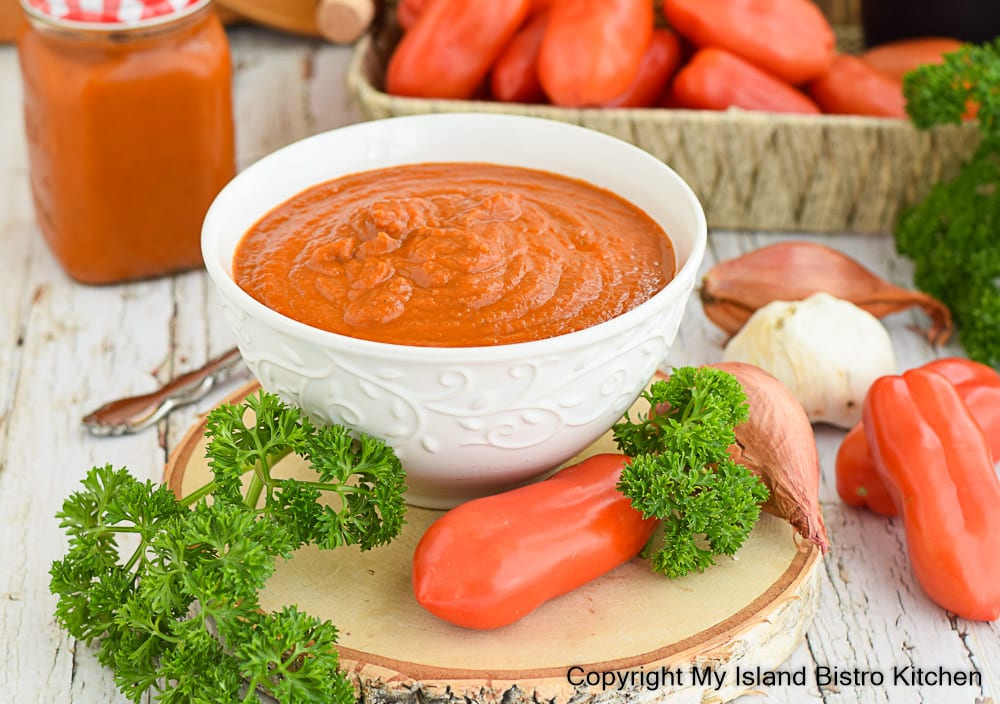
There is nothing like a good, flavorful homemade tomato sauce. This sauce, made with fresh tomatoes, is fabulous over pasta or used as an ingredient in any recipe that calls for tomato sauce.
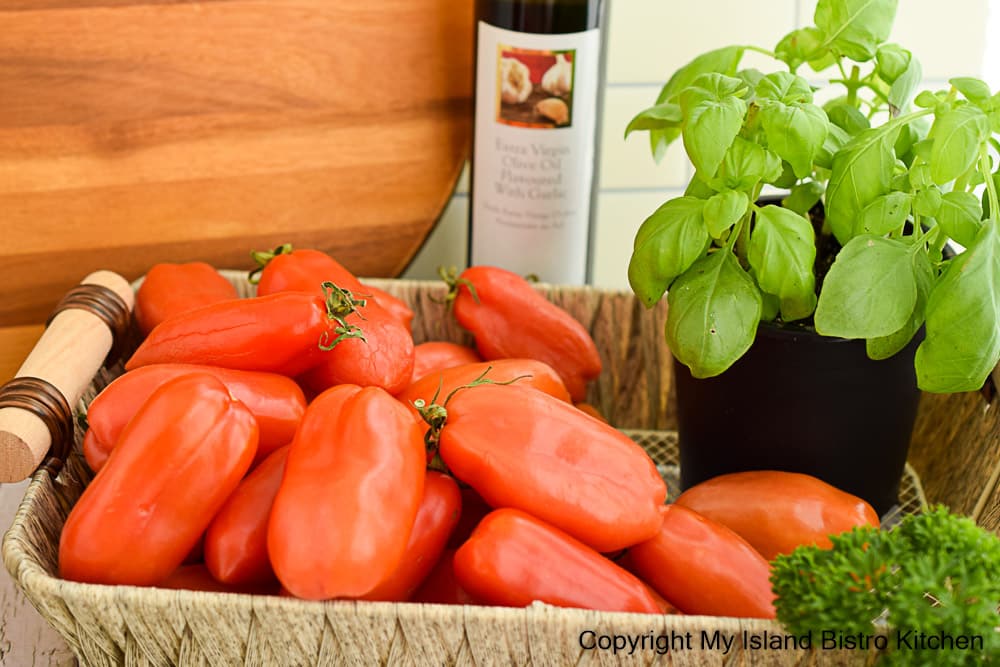
Tomato sauce is not particularly difficult to make but there are some steps and time involved and choice of type and variety of tomatoes used is key.
As we all know, a tomato sauce is only as good as the tomatoes used in it. Plum tomatoes (sometimes known as “paste tomatoes”) are the preferred type of tomato used for making tomato sauce. These are oblong/oval-shaped tomatoes that resemble the shape of a plum and they have more dense flesh than the typical table variety of tomatoes. A key difference between plum tomatoes and the common round-shaped tomatoes (the kind you would plate or use in a tomato sandwich, for example) is that plum tomatoes have only two seed compartments and this means they have more meat in them and less watery/gelatinous sacks to be cleaned out for making tomato sauce than do other types of tomatoes. There are several varieties of plum tomatoes but two of the more commonly known ones are San Marzano and Roma.
I recommend San Marzano tomatoes (shown in the photo below) though Roma tomatoes are a good substitute if you can’t find, or don’t grow your own, San Marzanos. San Marzano tomatoes originated in a small town in Italy by the same name.
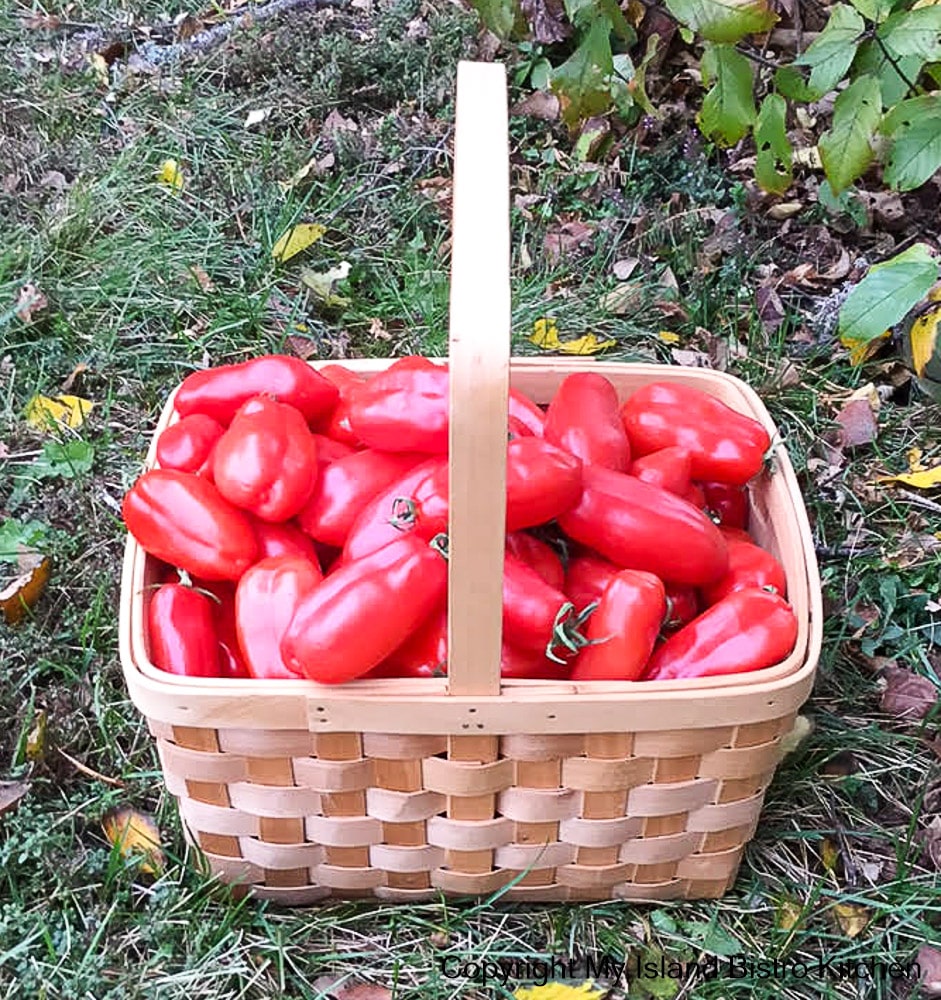
San Marzanos are the elongated skinny tomatoes with pointed ends as shown in the photos above and below. They have thin skins, thick walls of dense flesh/pulp, fewer seeds, and a lot less gelatinous/watery/jelly-like interior than other types of tomatoes. With their low moisture content and meaty flesh, they have good intense flavor with sweet notes. You get a lot more bang for the buck with San Marzanos as they are almost all meaty flesh. I grew them in my garden and found they grow quite easily and were really prolific producers. The basket full of tomatoes shown above was about one-fifth of what my San Marzano plants produced!
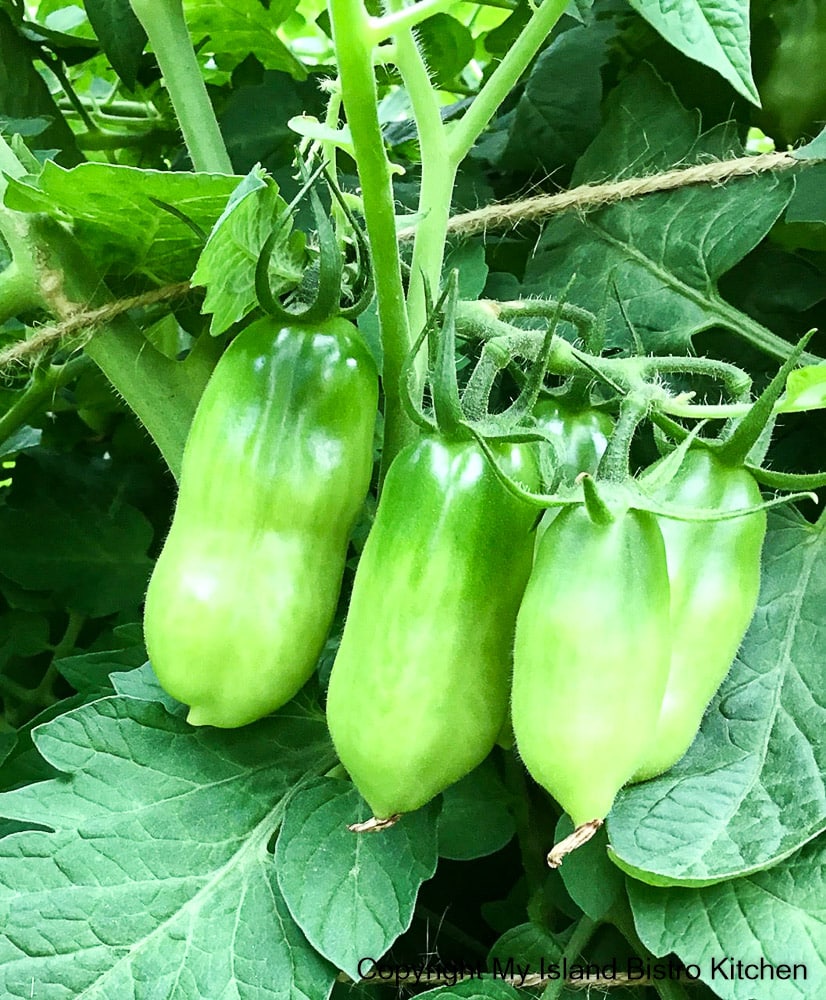
My recipe is based on using plum tomatoes (the sauce in the photos in this posting was made with San Marzanos from my garden). I can’t say how the sauce would turn out if a type of tomato other than a plum variety is used but I suspect it could be quite watery. A lot of the “garden variety” of tomatoes are heavily laden with seeds and a watery/jelly-like interior that would need to be removed, leaving little flesh with which to make a quality sauce.
While I do not recommend using a type of tomato other than a plum variety for this tomato sauce, if choosing to do so, it is likely more than the 10 pounds of tomatoes called for in my recipe would be needed to make up for all the seeds and gelatinous interiors of the tomatoes that would need to be removed and discarded before making a sauce.
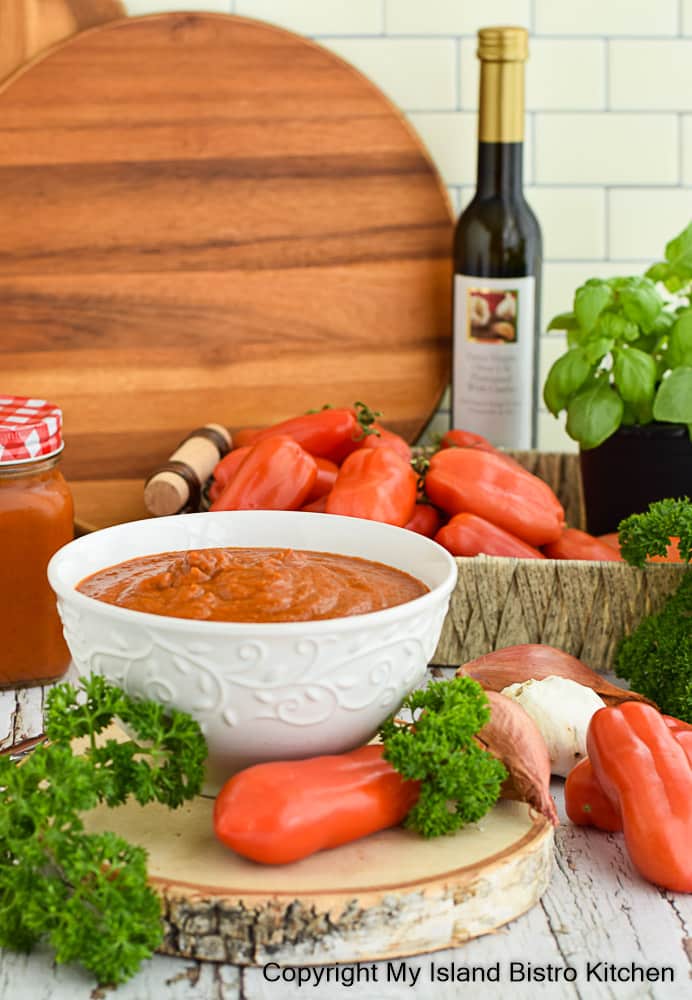
Many gardeners grow plum tomatoes specifically for making tomato sauce but, if you haven’t grown any plum variety of tomatoes (or don’t garden at all) and wish to make tomato sauce, you may want to check with your local farm stands as many do sell plum tomatoes of some variety that would be suitable for sauce making.
An entire head of garlic cloves is called for in my recipe. However, garlic is a taste so, if you are not fond of garlic, reduce the amount. Conversely, if you are a garlic lover and like a bit more kick to the sauce, add more garlic. The same holds true for the spices called for in the recipe. I tend to go with a moderate amount of seasoning but the amounts added to the sauce are completely up to the cook’s taste. I typically use dried herbs in this recipe but, if you have fresh herbs and wish to use them, they can certainly be used. As a rough estimate of how much fresh to substitute for the dried herbs, I’d suggest using the ratio of 1 tablespoon of fresh herbs for each teaspoon of dried. That’s just a general guideline, though, and seasoning of a tomato sauce is very much a personal thing so feel free to adjust the amounts of herbs in accordance with your own taste preferences.
To really add depth of flavor to this tomato sauce, include a bold dry red wine (into the sauce, that is! What the cook samples on the side, well, what happens in the kitchen stays in the kitchen!). The red wine will give a rich, robust flavor and vibrancy to the sauce. As always, when including wine as an ingredient, use a wine you’d be willing to drink. Don’t use a cooking wine, or some kind of imitation wine, off the supermarket shelf. No, just don’t do it.
A food mill (shown in photo below) is a really useful tool when prepping the tomatoes for the sauce and I recommend the use of one for this recipe. The tomato pulp and juice needed for the sauce is segregated out and the tomato skins and seeds are left in the food mill. The tomato seeds need to be removed before making tomato sauce as the seeds, during the long simmering cooking process, can tend to leave bitter notes in the sauce plus they are going to have to be strained out at some point anyway. Using a food mill is a simpler way to prepare the tomatoes than removing the skins by hand and cutting out the seeds and any gelatinous sacks in each tomato. Ten pounds of tomatoes is a significant amount of tomatoes to prep for the sauce and, using a food mill, is one way to lessen the workload (plus, it will give your arm a good workout at the same time!).
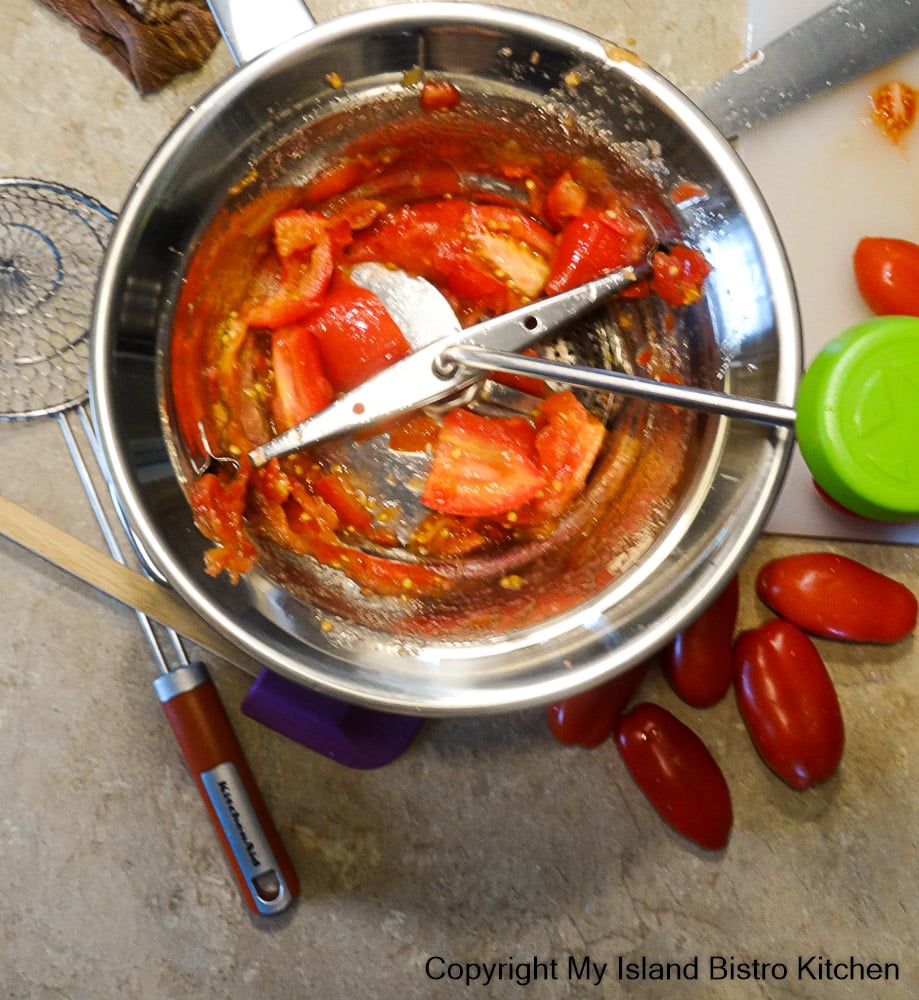
Once the tomatoes are prepped and the aromatics have been sautéed, it’s a matter of combining the two and letting the sauce simmer away on low heat for 2-3 hours (or even longer) to allow flavors to develop and the sauce to reduce and naturally thicken. Keep an eye on the sauce so that it does not scorch and adjust the heat accordingly. Stir the sauce occasionally. The longer the sauce simmers, the more it will reduce down and thicken naturally and the deeper the flavor will be. Low and slow is the message here. Two to three hours of simmering the sauce is a guideline. Simmering it longer won’t hurt the sauce and is likely to deepen the flavor and thicken the sauce more though it will result in less yield as it cooks down. Look at that gorgeous rich natural color of sauce that came from the lovely red San Marzanos!
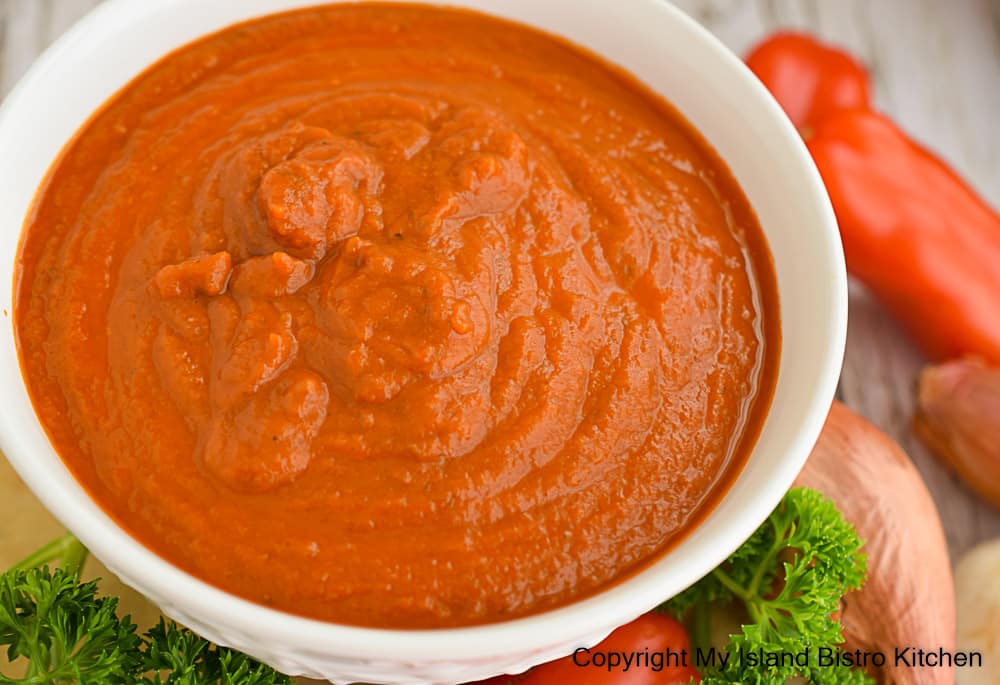
If you like a somewhat chunky sauce, leave it as is; if, however, you prefer a smoother, more refined sauce, then let it cool a little bit and then use either an immersion blender or standard blender to purée it to the desired consistency. Further straining the sauce through a wire mesh sieve will yield an even smoother sauce if it is desired.
This sauce freezes very well. I recommend freezing it in either airtight freezer-safe containers or zippered freezer bags. It’s a good idea to freeze it in proportioned amounts you know you will need, either for serving over pasta or using in favorite recipes. Generally, 10-12 cups of sauce can be expected from this recipe, depending on the quality and variety of tomatoes used as well as how much the sauce is cooked down and thickened.
[Printable recipe follows at end of post]
Tomato Sauce
Ingredients:
10 lbs ripe, firm plum tomatoes (e.g., Roma or San Marzano tomatoes), washed and quartered
4-5 tbsp olive oil
1 1/3 cups shallots, finely chopped
1 cup celery, finely chopped
1 cup carrots, finely chopped
2/3 cup green pepper, finely chopped
Head of garlic cloves, minced
2 – 5.5 oz cans tomato paste
2 tbsp brown sugar
1 cup bold dry red wine
¾ tsp nutmeg
1½ tbsp dried parsley
1 tbsp dried Italian seasoning
2½ tsp dried basil
2 tsp dried oregano
½ tsp dried thyme
1 tsp dried rosemary, crushed
1/8 tsp ground cloves
Sea salt and cracked pepper, to taste
Equipment Needed:
Food Mill
Immersion Blender or Standard Blender
Sauté Pan
Large Stockpot
Method:
Put tomatoes through food mill fitted with a medium grind disk. Discard the seeds and tomato skins left in the food mill from the straining of the tomatoes. Be sure to scrape off the pulp from the bottom of the food mill and include it with the strained tomatoes. Depending on the quality of the tomatoes, this should yield approximately 13 – 14 cups of strained tomatoes.
Heat olive oil in large stockpot over medium-high heat. Add the shallots, celery, carrots, and green pepper. Reduce heat to medium and sauté, stirring frequently, for 8-10 minutes or until vegetables have softened and shallots have become transparent. Add the minced garlic cloves and stir briskly for approximately 30-60 seconds, until garlic has become fragrant. Do not let garlic scorch.
Reduce heat to medium-low and add the strained tomatoes, tomato paste, brown sugar, red wine, and spices along with the salt and pepper. Stir well and increase heat to medium high, bringing mixture just to the boiling point. Immediately reduce heat to a low simmer. Cook sauce slowly for 2-3 hours, or longer, to allow flavors to develop and sauce to reduce and thicken. Stir occasionally to ensure sauce is not sticking to bottom of pot. When thickened to desired consistency, remove sauce from stove.
Sauce may be left and used as is or, for a smoother sauce, use an immersion blender after sauce has cooled slightly or, alternatively, transfer mixture to a blender to purée to desired texture. Passing puréed sauce through a wire mesh sieve will yield an even smoother sauce. Sauce may be frozen in airtight containers or zippered freezer bags of desired serving size. Use sauce as is over pasta of choice or as an ingredient in any recipe calling for tomato sauce.
Yield: Approximately 10-12 cups depending on quality of tomatoes and how long the sauce is cooked and reduced.
If you have made this recipe and enjoyed it and/or wish to share it with your friends and family, please do so on social media but be sure to share the direct link to this posting from my website.

Tomato Sauce
Ingredients
- 10 lbs ripe, firm plum tomatoes (e.g., Roma or San Marzano tomatoes), washed and quartered
- 4-5 tbsp olive oil
- 1 1/3 cups shallots, finely chopped
- 1 cup celery, finely chopped
- 1 cup carrots, finely chopped
- 2/3 cup green pepper, finely chopped
- Head of garlic cloves, minced
- 2 – 5.5 oz cans tomato paste
- 2 tbsp brown sugar
- 1 cup bold dry red wine
- ¾ tsp nutmeg
- 1½ tbsp dried parsley
- 1 tbsp dried Italian seasoning
- 2½ tsp dried basil
- 2 tsp dried oregano
- ½ tsp dried thyme
- 1 tsp dried rosemary, crushed
- 1/8 tsp ground cloves
- Sea salt and cracked pepper, to taste
Instructions
- Put tomatoes through food mill fitted with a medium grind disk. Discard the seeds and tomato skins left in the food mill from the straining of the tomatoes. Be sure to scrape off the pulp from the bottom of the food mill and include it with the strained tomatoes. Depending on the quality of the tomatoes, this should yield approximately 13 – 14 cups of strained tomatoes.
- Heat olive oil in large stockpot over medium-high heat. Add the shallots, celery, carrots, and green pepper. Reduce heat to medium and sauté, stirring frequently, for 8-10 minutes or until vegetables have softened and shallots have become transparent. Add the minced garlic cloves and stir briskly for approximately 30-60 seconds, until garlic has become fragrant. Do not let garlic scorch.
- Reduce heat to medium-low and add the strained tomatoes, tomato paste, brown sugar, red wine, and spices along with the salt and pepper. Stir well and increase heat to medium high, bringing mixture just to the boiling point. Immediately reduce heat to a low simmer. Cook sauce slowly for 2-3 hours, or longer, to allow flavors to develop and sauce to reduce and thicken. Stir occasionally to ensure sauce is not sticking to bottom of pot. When thickened to desired consistency, remove sauce from stove.
- Sauce may be left and used as is or, for a smoother sauce, use an immersion blender after sauce has cooled slightly or, alternatively, transfer mixture to a blender to purée to desired texture. Passing puréed sauce through a wire mesh sieve will yield an even smoother sauce. Sauce may be frozen in airtight containers or zippered freezer bags of desired serving size. Use sauce as is over pasta of choice or as an ingredient in any recipe calling for tomato sauce.
Recipe Notes
Yield: Approximately 10-12 cups depending on quality of tomatoes and how long the sauce is cooked and reduced.
Copyright My Island Bistro Kitchen 2023
Connect with My Island Bistro Kitchen on Social Media
Join the Facebook page for My Island Bistro Kitchen: https://www.facebook.com/MyIslandBistroKitchen/
Follow “the Bistro” on Twitter: https://twitter.com/PEIBistro/
See the drool-worthy gallery of mouth-watering food photos from My Island Bistro Kitchen on Instagram: https://www.instagram.com/peibistro/
Follow “the Bistro” on Pinterest at https://www.pinterest.ca/peibistro/ and pin the Pinterest-ready photo at the end of this posting to your favorite Pinterest boards!
PIN ME TO PINTEREST FOR LATER!



